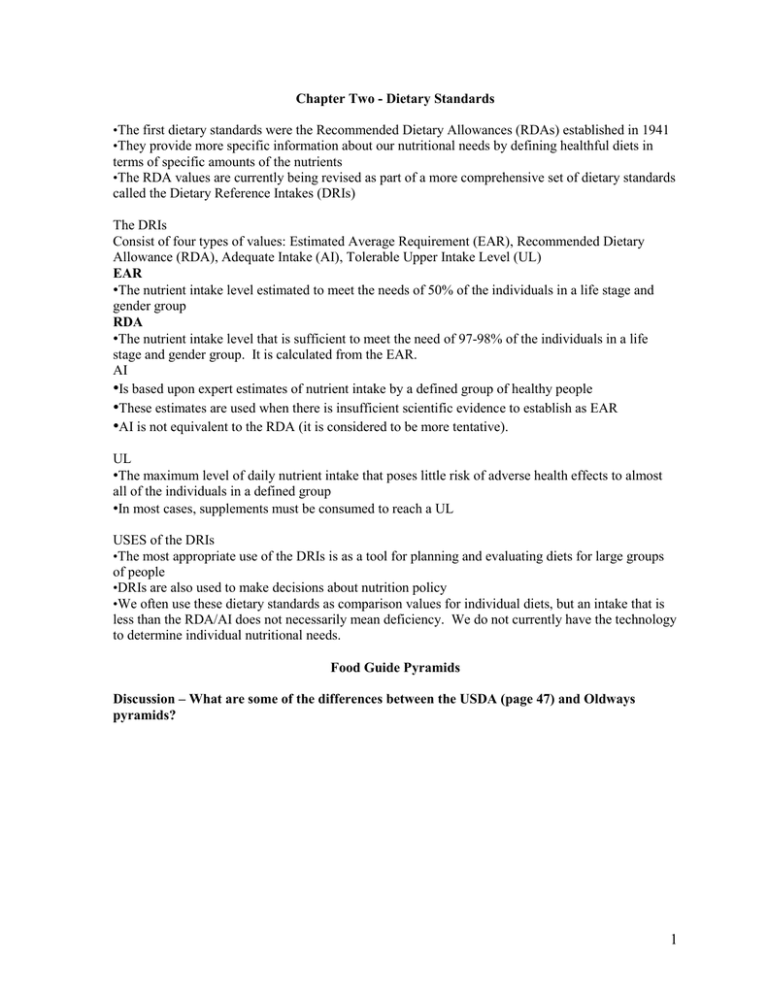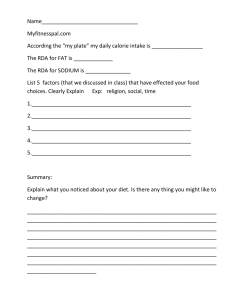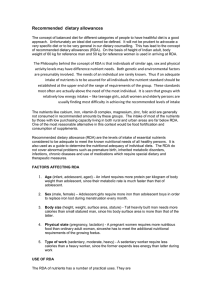Chapter Two - Dietary Standards
advertisement

Chapter Two - Dietary Standards •The first dietary standards were the Recommended Dietary Allowances (RDAs) established in 1941 •They provide more specific information about our nutritional needs by defining healthful diets in terms of specific amounts of the nutrients •The RDA values are currently being revised as part of a more comprehensive set of dietary standards called the Dietary Reference Intakes (DRIs) The DRIs Consist of four types of values: Estimated Average Requirement (EAR), Recommended Dietary Allowance (RDA), Adequate Intake (AI), Tolerable Upper Intake Level (UL) EAR •The nutrient intake level estimated to meet the needs of 50% of the individuals in a life stage and gender group RDA •The nutrient intake level that is sufficient to meet the need of 97-98% of the individuals in a life stage and gender group. It is calculated from the EAR. AI •Is based upon expert estimates of nutrient intake by a defined group of healthy people •These estimates are used when there is insufficient scientific evidence to establish as EAR •AI is not equivalent to the RDA (it is considered to be more tentative). UL •The maximum level of daily nutrient intake that poses little risk of adverse health effects to almost all of the individuals in a defined group •In most cases, supplements must be consumed to reach a UL USES of the DRIs •The most appropriate use of the DRIs is as a tool for planning and evaluating diets for large groups of people •DRIs are also used to make decisions about nutrition policy •We often use these dietary standards as comparison values for individual diets, but an intake that is less than the RDA/AI does not necessarily mean deficiency. We do not currently have the technology to determine individual nutritional needs. Food Guide Pyramids Discussion – What are some of the differences between the USDA (page 47) and Oldways pyramids? 1 Food Labels Five Mandatory Components: •A statement of identity: •The net contents of the package: •The name and address of the manufacturer, packer, or distributor •A list of ingredients: •Nutrition information Nutrition Facts Panel •Serving Size •Servings per container •Calories •List of nutrients (shown in quantity and as a percentage of the Daily Value) •%DV values for iron, calcium, Vitamin A, and Vitamin C (only micronutrients that must be on all standard labels) •Products that come in small packages can have abbreviated versions of the panel Daily Values (%DV) •Actually consists of two sets of values: the Reference Daily Intakes (RDIs) and the Daily Reference Values (DRVs) •RDIs provide comparison values for nutrients with RDA values like vitamins and most minerals •DRVs are for nutrients and other food components (cholesterol, fiber) for which RDA values do not exist Nutritional Assessment: ABCDs Anthropometric Measurement •Measurement of the physical characteristics of the body, such as height, weight, head circumference, and skinfold measurements •Examples: Growth grids, Metlife Tables, Body Mass Index (BMI) – commonly used in healthcare settings • BMI = relative weight for height (pages 259-260) Calculate your BMI: Biochemical Assessment •Measuring a nutrient or its metabolite (related compound) in one or more body fluids such as blood or urine, and in feces •Provide specific information about nutrients •Example: the concentration of albumin in the blood can be an indicator of the body’s protein status Clinical Observation 2 •Assessment by evaluating the characteristics of well-being that can be seen in a physical exam •While often non-specific, clinical signs are clues to a deficiency that can be confirmed or ruled out by further testing •Example: cracking at the corner of the mouth (suggestive of riboflavin, B6, or niacin deficiency) or small pinpoint hemorrhages (suggestive of a Vitamin C deficiency) Dietary Intake •Diet History – performed by a skilled interviewer and provides current as well as long-term dietary habits •Food Record – detailed information about day to day eating habits •Food Frequency Questionnaire – asks how often the subject consumes specific foods or food groups, rather than what specific foods are consumed daily •24 hour Recall – Interviewer takes the client through a recent 24 hour period 3



